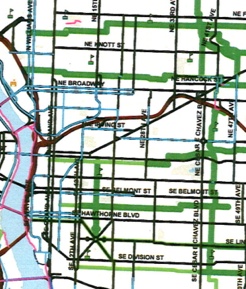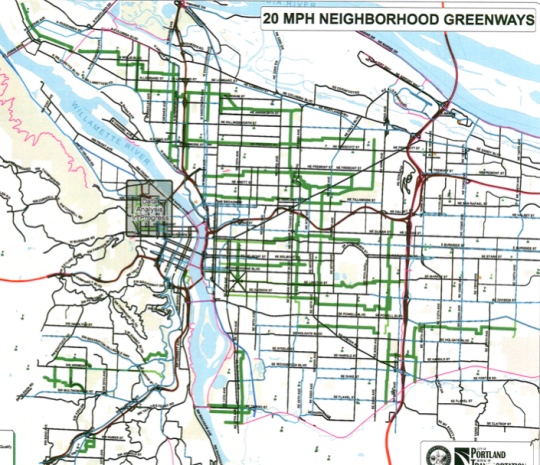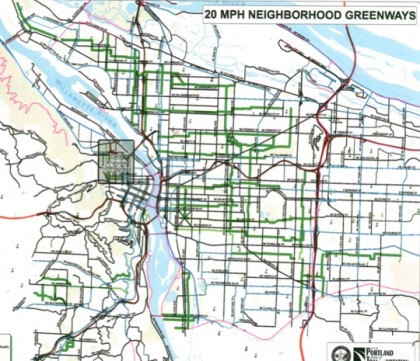
map? See larger version below.
At their meeting tomorrow, the Portland Bureau of Transportation (PBOT) will ask City Council to adopt a map of streets where they plan to install hundreds of new 20 mph signs.
Back in July, I shared details on how PBOT plans to roll out the new signs. The signs are the final piece of PBOT’s effort to lower speed limits on low-traffic neighborhood residential streets that are part of the existing neighborhood greenway network. (PBOT helped pass a state law in 2011 that gave them the authority to reduce speeds by 5 mph in certain circumstances.)
According to the ordinance filed by the City, they’re planning to install up to 300 new signs on 70 miles of streets. Most of the installations will be on already well-known neighborhood greenways streets in north, northeast, and southeast Portland. A few streets in southwest will also get the treatment, including portions of SW Illinois, Vermont, Maplewood, 52nd, SW Cheltenham, and others. Only a few of the signs will be installed downtown, with SW Harbor Way near Riverplace the only location in the plans. PBOT plans to eventually install some in the Pearl District/Northwest Portland area, but they are still analyzing data.
Here’s the full map (download PDF here):

PBOT must adhere to mandates in the new law, ORS 810.180, that says only streets that meet specific criteria can quality for the speed reduction. The streets must have fewer than 2,000 motor vehicles per day, have 85th percentile speeds (the speed at which 85% of the traffic is travelling) lower than 30 mph, and have pavement markings to indicate the presence of people walking and biking (sharrows).
These are the same criteria PBOT uses to identify neighborhood greenways streets, so in effect, the law will allow them to eventually sign every neighborhood greenway in Portland with a 20 mph speed limit.
PBOT pursued this speed limit reduction authority because they understand the connection between speed and safety. In the ordinance, they write:
“10. A pedestrian stuck at 20 MPH has a 95% chance of survival. If they are stuck at 30 MPH, the only have 60% chance of survival. A small difference in speed has significant benefit for safety.
11. On residential streets, creating 20 mile per hour travel speeds is an international best practice for improving safety and livability. The City of London has had 20 MPH residential zones for more than 20 years, which has led to a 40% reduction in traffic injuries and death attributable to the slower speed designation and networks of traffic calmed streets.”
PBOT expects this first wave of installations to cost about $30,000 to $45,000. If Council passes the ordinance, they’ll begin installing them immediately.

